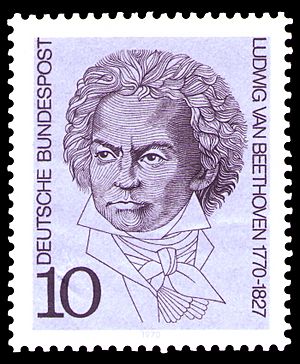Piano Sonata No. 8 (Beethoven) facts for kids
The Piano Sonata No. 8 in C minor, Op. 13, often called the "Pathétique" Sonata, is a famous piece of music for solo piano. It was written by the well-known composer Ludwig van Beethoven. He created this sonata between 1797 and 1798. It was first published in Vienna, Austria, in 1799. The "Op. 13" part means it was the 13th work Beethoven published.
This sonata is special because it has three main parts, called movements. Each movement has a different feeling and speed.
Contents
What is a Sonata?
A sonata is a type of musical piece. It is usually for one or two instruments. Sonatas often have several movements. These movements are like different chapters in a book. They usually have contrasting moods and speeds.
The Three Movements
The "Pathétique" Sonata has three distinct movements. Each one tells a part of the musical story.
First Movement: Grave – Allegro di molto e con brio
The first movement starts slowly and seriously. This part is called "Grave," which means very slow and solemn. It sets a thoughtful mood. After this slow start, the music quickly changes. It becomes fast and energetic, marked "Allegro di molto e con brio." This means very fast and with spirit.
This fast section uses a special musical form called sonata form. It has a strong, driving rhythm. The left hand on the piano often plays fast, repeating notes called tremolando octaves. This makes the music sound powerful and exciting. The whole movement feels like a journey, full of questions and changing emotions.
Second Movement: Adagio cantabile
The second movement is much slower and very beautiful. It is marked "Adagio cantabile," meaning slowly and in a singing style. This part is in a musical form called rondo. In a rondo, a main melody keeps coming back. It's like a chorus in a song.
This movement is known for its calm and peaceful feeling. It is one of Beethoven's most loved melodies. Many people find it very moving and comforting.
Third Movement: Rondo: Allegro
The third and final movement is fast and lively. It is another rondo, so the main theme returns several times. This movement has a slightly sad or thoughtful feeling, which is called melancholic.
The main tune is often played with fast, broken chords in the left hand. These are called arpeggios. The movement builds up energy and excitement. It ends with a brilliant and powerful finish, known as a coda. A coda is like a grand ending to a piece of music.
See also
 In Spanish: Sonata para piano n.º 8 (Beethoven) para niños
In Spanish: Sonata para piano n.º 8 (Beethoven) para niños
Further Reading
- Woodstra, Chris, et. al. 2005. All Music Guide to Classical Music. All Media Guide, LLC. p. 108. ISBN: 0-87930-865-6.


